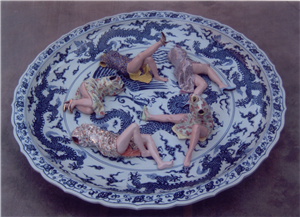
1999. Liu Jianhua “The Painted Sculpture Series: the Memory of Infatuation and Merriment.”
The photograph above depicts a sculpture of give figurines of female bodies, exposed in sexual positions in the Chinese traditional qipao. The artist, Liu Jianhua, is a Chinese male who created a whole series of sculptures similar to this from 1999-2000 called “The Painted Sculpture Series: the Memory of Infatuation and Merriment.” The picture above is a sample sculpture from the series. The little figures on the sculpture have clear female anatomy, but they lack heads and arms. Some of them are also lacking shoes. The qipao-dressed figurines are sprawled in many sexual positions, some of which exposing their entire legs and undergarments. The sculptures are laid on an intricately decorated plate in blue and white.
Based on the photo’s depiction of hypersexualized women in a demeaning way, the artist challenged China’s standards of women and the social implications of the qipao. This provocative piece, and its entire collection, does not leave room for interpretation or consideration of other viewpoints, besides an offended one. Although it is very possible to assume that the artist truly viewed women in this misogynistic light, I believe that the message of this piece is deeper than surface level–to provoke the audience to consider a more nuanced view of the qipao and its negative influence on women’s roles and respect in Chinese society.
The first detail of the sculpture that stood out to me was the array of provocative positions the female bodies lay in. The qipao is an indication of femininity, but it often still relied on keeping the mystery of the female body under the clothes without much skin exposure. The sculptures revealed skin exposure as well as undergarments, as if to mock the illusion that qipaos actually promoted society to respect women more. The artist shows his discontent with female portrayal in society by highlighting the real crime against women–the belittlement and hyper-sexualization. He is criticizing the dominant society by exposing the real problems of eroticisation that are hidden under gender norms.
i am trying to understand the idea of exposing the female body and respecting women
The decision to remove the heads and arms from the sculptures further dehumanize the female bodies, as if to reduce them from real women to the easily sexualized parts of them. It gives the impression that women do not have the ability to run away from the male gaze or protect themselves from the possible harm they could endure when wearing provocative clothing. The artist indicates another level of subjectivity the female body endures when in the famous qipao clothing.
A subtle, but important aspect of the sculpture is the fact that the figures are on an intricate place with dragons. Dragons on a qipao indicate adaptability and are an important aspect of respectability. However, this beauty distracts from the issue that the female bodies are being served on a plate, as if they are ready for anyone to take and use them. In further imagery, the female bodies are visualized as objects, with no form of choice to resist manipulation. The artist’s creativity in providing commentary on the degrading representation of Chinese women in qipao’s is provocative, but blatant.
There are many aspects of this artwork that could be analyzed, but I chose to focus on the aspects of this representation of the qipao that I thought were the most prominent. The artist made a statement that cannot easily be ignored that comments on the hyper-sexualization of Chinese women, specifically in the qipao. The tradition of the qipao started in a more conservative light, but the modern qipao was used to eroticize and feshize the Chinese woman, especially globally. This was an attack on the Chinese female dignity and respect. If society were able to acknowledge and address the prevalent degradation of women in a more straight forward way like this piece of artwork, then perhaps the qipao would symbolize the cultural aspects of fashion more and less of a sex-symbol for women.
suggestion: good work, but clarify the argument and adjust the organization
